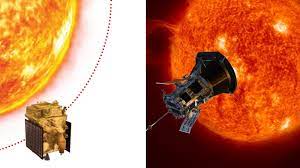
ISRO Aditya L1 vs. NASA Parker Solar Probe Their Sun’s Study Mission: India’s Aditya L1 and NASA’s Parker Solar Probe are both pioneering solar missions aiming to unravel the secrets of the Sun. While their goals are similar, their approaches, technology, and closeness to the Sun differ. This essay compares and contrasts these two exceptional missions.
Daily Current Affairs Quiz: August 2023
ISRO Aditya L1 Vs. NASA Parker Solar Probe: Mission Overview
Aditya L1: India’s Solar Mission
- Launch Date: Scheduled for September 2, via ISRO’s Polar Satellite Launch Vehicle (PSLV C-57).
- Orbit: Positioned at the L1 Lagrange point, 1.5 million kilometers from Earth, ensuring uninterrupted solar observation.
- Objective: Dedicated to studying the Sun’s activities and potential impacts on Earth’s technology.
- Instruments: Carries seven specialized instruments to capture images, analyze particles, measure magnetic fields, and study the Sun’s layers.
Parker Solar Probe: NASA’s Solar Endeavor
- Launch Date: Launched in 2018.
- Orbit: Orbits within 3.9 million miles of the Sun’s surface, venturing into the scorching corona.
- Objective: Investigate the solar corona, solar wind, and high-energy particles, as well as solar dynamics and space weather.
- Instruments: Equipped with four scientific instruments focusing on magnetic fields, plasma, energetic particles, and solar wind imaging.
Proximity to the Sun: A Key Contrast
- Aditya L1: Positioned strategically at the L1 Lagrange point, offering continuous observation from a distance.
- Parker Solar Probe: Unprecedentedly close to the Sun’s surface, within the corona, enduring extreme heat and radiation for direct data collection.
Differences in Payloads
Aditya L1’s Payloads
- VELC: Captures images and spectral data of the solar corona, providing insights into its temperature, velocity, and density.
- SUIT: High-resolution photography of the photosphere and chromosphere is provided, assisting in the understanding of these essential solar layers.
- SoLEXS: Observes soft X-rays, revealing surface activity on the Sun.
- HEL1OS: Provides crucial hard X-ray data for insights into high-energy solar phenomena.
- ASPEX: Enables in-situ analysis of solar wind particles, particularly protons and heavier ions.
- PAPA: Analyzes electrons and heavier ions in the solar wind through in-situ observations.
- Advanced Tri-axial High-Resolution Digital Magnetometers: Measures magnetic fields in the solar corona.
Parker Solar Probe’s Payloads
- FIELDS: Studies magnetic fields.
- ISIS: Investigates plasma.
- WISPR: Images the solar wind.
- SWEAP: Analyzes solar wind electrons, alphas, and protons.
ISRO Aditya L1 Vs. NASA Parker Solar Probe: Mission Objectives
- Aditya L1: Continuous monitoring from a distance to provide insights into solar activities and their potential impacts on Earth’s technology.
- Parker Solar Probe: Close encounters yield insights into solar wind acceleration, aiding predictions of satellite and communication system disruptions.
Solar Mission Landscape
Several other space agencies, including ESA, Japan, China, and Russia, have contributed to solar exploration. In 2018, NASA launched the Parker Solar Probe in collaboration with ESA, aiming to make direct contact with the Sun’s corona. The ‘Solar Orbiter,’ a NASA-ESA collaboration set to launch in 2020, intends to improve understanding of the Sun’s influence on space.





